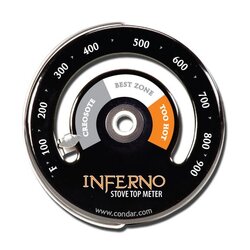BrotherBart said:
It is easier to over fire the newer stoves because of the inability to completely shut off the primary intake air and the unrestricted secondary air intake in a non-cat stove
I don't know about other old stoves, but I can practically melt my old Vigilant if I'm not careful. As it is, I've had stove face temp spikes over 1000º F on the IR gun, all while waiting for the damn thing to calm down... even after the bypass damper is shut and the primary air closed. Stove top routinely gets to over 800º, even on a half load.
I have fond memories of making out with my GF while sitting in the dark of her family room, her pretty face faintly illuminated by the red glow of the wood stove. I have no idea what kind of stove it was, but they
always over-fired the thing, and it kept on ticking.
Still, most of the older stoves are heavily damaged on the inside from burning too hot. Not just warping and cracking plates, but the slow and inexorable deterioration of internal parts due to long term over-firing. I just gave my old Jotul 118 clone away to a guy to use in his shop. It was on it's fifth set of side baffle plates, and needs a sixth (I make my own out of 1/4" steel). Run it hot and you burn right through them in a couple of years. Eventually, I burned a hole right through the top baffle, but they were designed to be replaced as well. Even on my cheapo stove, the plates themselves are still in fine condition after all those years of burning hot as I could. Now, all the stove cement was blown out, but those old stoves were also designed to be rebuilt every five years or so, part of the general maintenance of the thing.
We have gotten so used to living in a throw away society. I'm on my fourth line trimmer in five years. The old electric Weed Eater just wouldn't die (10 years of steady use) until I left it in the rain and used it right after. I went with gas powered after that and they cost more to service than a new one costs, so I went back to electrics. My B&D Grass Hog just died yesterday - exactly one day after the two-year warranty expired. I was going to pick up a new Sawzall because they are supposed to have more power, but I'm told you can't even put new brushes in yourself. My old 8 amp saw still cuts like it was brand new, and when the brushes go, you just pop them in. All quality things from the past were designed to be used hard and rebuilt when they wore. Now, it seems that even something enduring like a wood stove has become a semi-permanent appliance if you give it just a little bit of abuse.





 hh:
hh: